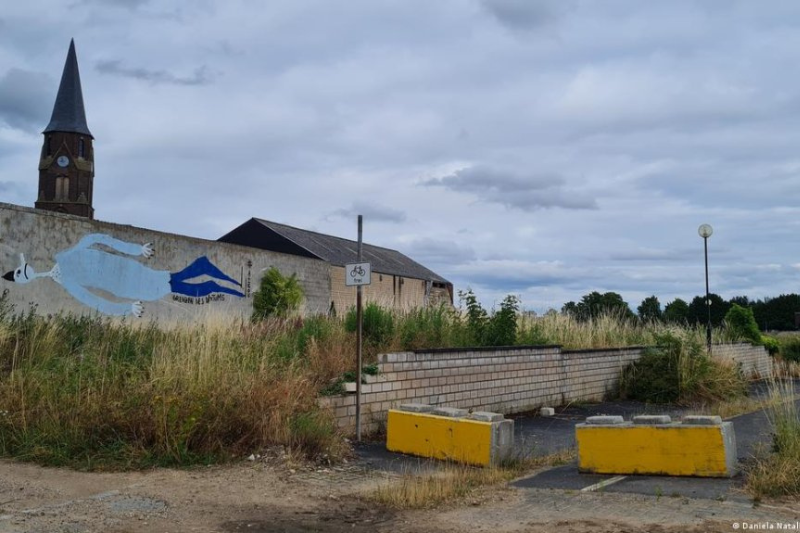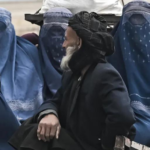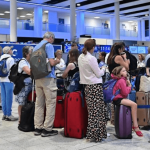
ukraine refugees in mining ghost towns in germany
Entire villages in the coal region of western Germany were vacated to make room for mining. Refugees from the war in Ukraine have since resettled in the towns.
Three sizable pale patches can be seen if you open Google Maps and look at the state of North Rhine-Westphalia in western Germany. They stand in for the three enormous open-pit mines, Inden, Hambach, and Garzweiler, from which the energy provider RWE is mining brown coal (lignite).
There are towns and villages right nearby that have lain empty for weeks or, in some cases, years. Originally planned for demolition to make way for more mining, the future of these “ghost towns” is now uncertain due to Germany’s decision to phase out coal.
The two “ghost villages” of Morschenich and Manheim, which were allegedly destined to be demolished to make way for mining, are located close to the Hambach surface mine, which began operating in 1978 and is scheduled to shut down by 2030.
As you enter Manheim, you notice a row of homes with boarded-up windows and rolled-down shutters. Both the street lights and the asphalt road are damaged. There is a Catholic church in the middle of the community, and its windows are also boarded up. Some houses are still in good condition but are encircled by barbed wire. Their owner is identified on a sign as RWE.
“We’re not at all complaining,”
Here, you don’t run into many people. Technically, there shouldn’t be any at all, just like in the nearby town of Morschenich. There are also countless rows of empty houses, with their windows covered and the grass in front growing tall. You could initially mistake it for another “ghost village.”
However, if you pay close attention, you’ll notice that some of the homes in Morschenich have labels made of white paper stuck to their doors. One has a name that is Ukrainian and the other is Arabic. A Ukrainian couple named Denis and Julia whose names have been changed to protect their identity live in one of these.
They informed DW that they had resided in Morschenich since December 2022. The once single occupancy house is now occupied by several people, including a Syrian refugee family and a Ukrainian family from the Donbas.
“We have no complaints at all. We have Wi-Fi and mobile internet, as well as electricity, water, and heating, claims Denis.’ We can call Ukraine home. We receive weekly visits from local government employees who assist us with paperwork. We frequently receive social welfare benefits. We’ve only been missing language classes so far.
They are unconcerned by the town’s lack of stores, drugstores, or physicians. To get groceries, Julia makes a trip to the nearby village, she explains. A vehicle with Ukrainian license plates is parked next to the home.
“When we first arrived, we had no idea what was going on. Someone later described the location’s nature to us. We had been under attack for three months back home in Ukraine, but now everything is quiet,” they claim.
They indicate where the woods start, just across from a field. There are climate activists there, says Denis. “They constructed residences in the trees’. Even though we occasionally see them, they don’t bother us. He continues by saying that the police frequently stop by to make sure all is well.
Several Ukrainian families are currently residing in Morschenich. When neighborhood watchmen or walkers pass by, Denis and Julia see them. At first glance, this place appears dull, but we go berry picking, says Julia.
Denis continues, We occasionally go into town, but it’s so noisy there that we are glad to get back to the country.
The couple claims they are unsure of how long they will remain here. It seems they won’t destroy this village. We were initially in a refugee camp in [the nearby city of Bochum, but the municipality sent us here, so we’ll remain here until they relocate us, says Julia.
According to the most recent plans, Morschenich will be spared destruction. Germany has committed to completely phase out coal-fired power plants by 2038 as part of its effort to reduce carbon emissions.
Keep Reading
RWE informed DW of the plan. The spokesperson said The locations mentioned are no longer scheduled for demolition. “At the request of the local authorities, we made the houses and flats in question, which we had previously purchased from families being relocated, available to people in need of a roof over their heads immediately.“
Previously a school, now a refuge
The settlements of Kuckum and Keyenberg are close by, situated close to another surface mine known as Garzweiler II. Additionally, the homes of the locals were purchased, and they were moved. The two towns are about to vanish.
Next door is the village of Lützerath, where Swedish youth activist Greta Thunberg visited earlier this year as part of a wave of climate protests. All of the roads leading there are closed, and they will also be destroyed this year.
But a car can still get you to Keyenberg. It appears identical to the other abandoned villages at first glance: the same congested streets, rows of sturdy but empty homes, and a Catholic church.
The school building is located a short distance further down the street, where several people appear out of nowhere. Chairs are brought outside with them and placed in the schoolyard. It is a warm day.
Our home is here. One man says, “We’re from Syria,” and then he quickly vanishes. It’s unclear if they live there. Nobody wants to talk, so everyone retreats inside the structure.
A bus stop with a schedule is located close to the school. There are still bus and train services in Keyenberg. The opening hours of a bakery next to the church are written on the door; on some days of the week, they are only a few hours. Nearly all of the shops are empty, and there are no longer any real stores or pharmacies here.
However, the numerous parked cars indicate that some of the houses are occupied.
Although Keyenberg still has residents, about 80% of them have left after receiving compensation. According to Irina Becker, a center-right Christian Democratic Union (CDU) city councilor in the nearby city of Bochum, “about 15-20% are still there.”
Additionally, refugees are currently residing here, Becker, a member of the integration committee for the Bochum council, added. For them, the old school has been prepared. Several houses are also used as lodging. Some are used exclusively, while others are shared accommodations.
There is heating, water, and electricity. She claims that language and integration classes have been set up for the refugees living here, and the kids attend preschool.
Who is relocating refugees to run-down towns?
In Keyenberg, there is also a Ukrainian family with a young child. They refuse to give their names but say they lived “in Poland for a long time.” They discovered via social media that you could visit Bochum and be placed in a significant city like Düsseldorf or Cologne. However, they claim that state authorities ultimately sent them to Keyenberg after first sending them to the smaller town of Erkelenz.
According to predetermined quotas, refugees are automatically distributed among Germany’s 16 states and thousands of municipalities, and housing is distributed based on need.
The Keyenberg-based family of Ukrainian refugees claims to enjoy the community. They are currently the only family in the home, but another Ukrainian family is anticipated to move in soon. They acknowledge that at first, they were concerned. But they argue that living here is preferable to lying on a mat in a gym somewhere, remembering their friends who still live in that manner.
They do not want to go back as long as there is conflict in Ukraine. After the war is over, they might decide to remain in Germany. Let’s see, the Ukrainians claim that everything is fine at the moment. The community won’t be destroyed. Depending on whether we can stay here.









